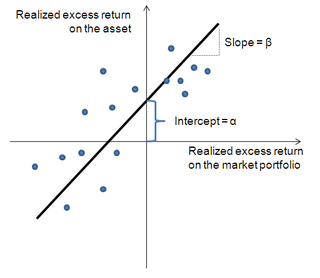
Positive abnormal return (α): Above-average returns that cannot be explained as compensation for added risk
Negative abnormal returns (α): Below-average returns that cannot be explained by below-market risk
Security characteristic line (SCL) is a regression line, [1] plotting performance of a particular security or portfolio against that of the market portfolio at every point in time. The SCL is plotted on a graph where the Y-axis is the excess return on a security over the risk-free return and the X-axis is the excess return of the market in general. The slope of the SCL is the security's beta, and the intercept is its alpha. [2]

